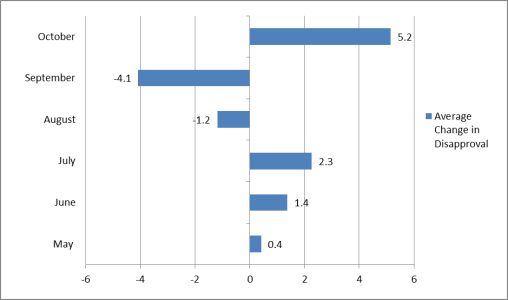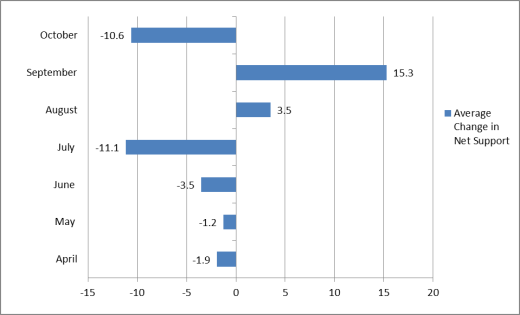The last set of posts reported on Abe arresting his declining cabinet support rate, and then reversing the trend after the cabinet reshuffle. A series of “scandals” involving these new cabinet members and financial and electoral improprieties has greatly undermined the working of the new cabinet, and Abe appears to be back where he was in July after the first round of post-CSD declaration polls came in.
Approval: Abe’s Popularity Declines
On the approval side of matters, the change has not been so severe. The polls from TV networks show a 4.8 percent average drop (Figure 1), with the traditional media showing a 6.1 percent drop, for an overall drop of 5.5 percent (Figure 3). For the latter result, however, we see the Nikkei and Yomiuri seeing rather larger drops compared to their rapid reaction polls taken immediately after the cabinet reshuffle (Figure 2). A lesson to be learned there for these two pro-LDP papers, perhaps, as the changes coming from these two polls has magnified Abe’s drop in approval.* Or it may well suggest that Abe’s increase in approval after the reshuffle was not really as high as initially estimated. Figure 4 shows that the drop in this month overall was as high as the drop that we saw after the Collective Self-Defense decision in July. Whether this is due to the cabinet failings, due to increasing frustration with the lack of progress on various reform measures, or due to the perhaps artificially high post-cabinet reshuffle numbers is another question (Click on figures to see full size).
Disapproval: Consistent Increases in almost all Polls
On the disapproval side, then there have been perhaps more worrying changes for Abe. Abe’s approval ratings have been bouncing around for a while now as voters appear ambivalent about his policy program. Disapproval seemed to move a little bit less dramatically, however. The last month saw reasonably significant upward movement in Abe’s disapproval after two months of improvement. Last month’s increase in disapproval was more than double the increase in disapproval after the CSD cabinet declaration in July (Figure 8). In this case, the upward trend in disapproval was more or less equally shared among the surveys, although a lack of movement from the Jiji and Asahi polls made this result less bad for Abe (Figure 6).
Abe’s Buffer: Net Support
Nonetheless, Abe has for close to two years managed to maintain a positive net support rate (Figure 9). While the last month was almost as bad as the decrease in his buffer in July (Figure 10), the lack of an effective opposition continues to ensure that he sits in the comfortable position (for a Japanese prime minister) of being more popular than unpopular.
Election Watch
Nevertheless, with much to do and the government suffering setbacks and the opposition going after the LDP in parliament, Abe has probably missed his chance to call a snap election this year under this cabinet, if this was ever really seriously on the cards at all. He would look like he was running scared and with few real achievements to call upon in campaigning. The LDP would still win, but would unlikely improve its position. If Abe’s reshuffle had seen two to three months of stability and a policy success or two, then a snap election, leading into early December, could have been a possibility. With budget season coming up, Abe and his cabinet tied up in parliamentary proceedings other than policy, it is unlikely that an early election will take place before August next year.
An ideal time for the LDP could be the unified local elections next year after the budget has been passed, something that will be less onerous for the LDP than it was during the DPJ years. However, Komeito is extremely unlikely to support this due to wanting to maximize their organizational resources during two separate campaigns rather than a local and a national one at the same time. After April, the LDP is likely to go into top gear to try and get legislation approved to make good on the commitments made in the US-Japan Revised Defense Guidelines, and any other enabling legislation deriving from the policy commitments noted in the July 1 cabinet declaration on Japan’s seamless defense that the LDP might be confident of getting through. Abe is likely to want to get through what he thinks he can get through reasonably uncontroversially, and then attack more controversial legislation perhaps after an election with a renewed mandate. This could be after the full term has been served, but it also wouldn’t surprise me if a snap election was called in August next year just before Abe goes up for reelection for the LDP leadership, if he is in any condition to contest one or the other of these elections. If Abe is strong, a national election before the LDP election would put him in a strong position to force through a change in LDP rules at some point to allow a third term as president, which would be required for him to serve out the full four years of a new House of Representatives term and avoid a mandatory change in LDP leader less than one year out from an election (and also allow Abe to just make it all the way to the Olympics if successful again in 2019). If Abe’s position at the time makes him vulnerable to a challenge, this would change the calculus again, however – an election is likely to take place after the LDP election in such a case.
But the way things have been going lately, and with Abe losing his aura of invincibility, these long-term scenarios look much more doubtful than they did even two months ago. And this will make it all the more difficult for him to tackle the already tough issues of nuclear power plant restarts, the consumption tax rise, and making concessions on the TPP.
* The Yomiuri in its polling after the cabinet reshuffle pushed respondents a little bit harder to come down on the side of either approval or disapproval than some of the other survey organizations.










Pingback: Not too early to start thinking about the 2016 election? | σ1